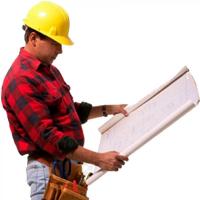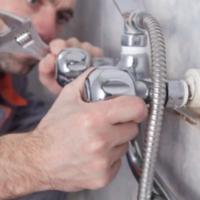How to Replace a Faucet
by Guest Post on Jan 12, 2010
Replacing an old or leaking faucet is not a difficult task and doesn’t require many tools. You will first need to select the right faucet replacement faucet, one that completely covers the mounting holes of the old faucet. The following steps will show you how to replace a faucet on a kitchen or bathroom sink.
How to Remove an Old Faucet:
Turn off the water supplyBoth hot and cold water valves located beneath the sink need to be shut off before you do any loosening of fittings. Turn on the faucet to drain away the remaining water and release any pressure.
Get proper tools
A monkey wrench or adjustable wrench is essential for the job. Because you will need to reach the fittings under the sink, a long basin wrench is also an important tool that allows you to grip the fitting at one end while turning the t-handle at the other.
Unscrew nuts and disconnect the faucet
Using the basin wrench, unscrew the nuts that attach the water supply hoses or pipes to the faucet and remove the hoses or pipes. Be careful not to unscrew the drain as well. Loosen the rest of the washers attaching the faucet to the sink. If the washers do not budge because of rust, apply penetrating oil to make the task easier. You can now remove the faucet from the sink.
Clean the area
To prepare the area for the new faucet, get rid of any buildup by dissolving it with a solution consisting of equal parts water and vinegar. Scrape the area clean with a putty knife or scouring pad.
How to Install a New Faucet:
Attach the faucet to the sink
Remove the washers on your new faucet and place them into the mounting holes at the top of the sink. Some faucets come with a gasket that serves as a seal between the faucet and the sink. Other faucets require the application of plumber’s putty around the faucet base to seal it onto the top of the sink. Under the sink, secure the faucet by placing the washers back on and tightening them by hand.
Connect to the water supply
Attach the water supply hoses to the faucet and then to the valves. Firmly tighten the nuts with the wrench, making sure that they are not over-tightened. Check that the hot and cold water supply valves are correctly fitted to the corresponding hoses leading to the faucet. Usually, the hot water is attached on the left and the cold water on the right.
Check for leaks
Turn the hot and cold water valves back on. Turn on the faucet to its full capacity and run the water for a few minutes to ensure there are no leaks. If you do see leakage, check all the connections and fittings and tighten them if necessary.
Popular Articles
Three Places to Spend Money on the Exterior of Your Home
When you have the exterior of your home remodeled, you are investing, time, energy and convenience into the project and you want to make sure that...
95708 Views
Homemade Headboards-Make an Upholstered or Wooden Headboard
Homemade headboards can add a lot of personality to any bedroom. They can be coordinated with existing furniture and room decor or they can be the...
74443 Views
When to Use a Brush, Roller or Sponge Brush
Brushes are a good choice for painting trim and woodwork. They are also useful for cutting in the edges around the top and bottom edges and corners...
71811 Views
Creating a Cottage Kitchen with Bead Board
Kitchen decor can range from modern and bold to elegant and elaborate by using strategic kitchen pieces. One of the most popular decorating trends...
52886 Views
Gas Fireplace Diagnostics and Troubleshooting
Follow these steps for diagnosing and troubleshooting Gas Fireplaces repairs. For the average DIYer, this may seem intimidating, depending on the...
30633 Views
Latest Articles
How Much Does It Cost To Take A Bath?
Plumbers know that a bath may seem like a relaxing luxury, but the real cost extends far beyond your water bill. The average soak uses 35 to 50...
on Apr 8, 2025
10 Concrete Patio Ideas on a Budget
A concrete patio can be a game-changer for your outdoor space. It is durable, versatile, and can be customized to fit your style. But what if you...
on Mar 25, 2025
Tips for Creating a Stunning Personalized Photo on Canvas
Order the unique beauty of a personalized photo on canvas and bring your memories to life. With a customized photo on canvas, you can transform...
on Mar 7, 2025
Best Areas to Buy Property in Singapore for Long-Term Growth
Singapore's real estate market remains one of the most stable and lucrative in the world. With limited land supply, strong governmental...
on Feb 18, 2025
Troubleshooting Excess Water in Your HVAC Secondary Condensate Drain Pan
When maintaining your air conditioning system, it is easy to overlook the condensate drain pan - until excess water starts pooling in places where...
on Jan 12, 2025
Featured Articles
What Type of Licensed Contractor Should You Hire?
on Feb 28, 2017
Hire Contractors / Estimates

Looking for a specialty project? There are many types of contractors available for your home improvement needs. Finding the right type of...
Sponsored Articles
Best Areas to Buy Property in Singapore for Long-Term Growth
on Feb 18, 2025
Real Estate / Finance

Singapore's real estate market remains one of the most stable and lucrative in the world. With limited land supply, strong governmental...
Actions
Top Categories
- Garden / Landscaping / Patio — 264
- Kitchen / Bathrooms — 240
- Real Estate / Finance — 203
- Appliance / Repair — 186
- Interior Design / Decor — 184
- HVAC / Air Conditioning — 148
- Cleaning / Maintenance — 144
- Improvements / Remodeling — 131
- Plumbing / Basements — 118
- Floors / Tile / Hardwood — 116
- Doors / Garages — 113
- Safety / Security — 113
Articles Archive
More DIY Articles
Office Desks for Home Provide more Functionality
The top of a home office desk is an important feature as the size; make, texture, and color of the desk determine the selection of other home...
DIY Method on Double Glazing Windows Installation
Double Glazed windows are an ideal asset to have in your home. Double glazing has long been associated with health benefits, as well as heat...
Common Problems with Automatic Garage Doors
Most homeowners invest in an automatic garage door for convenience. When the door stops responding or gets stuck in an open position, it can be...
How to Choose the Best French Door Refrigerator
French door refrigerators are full-width refrigerators with twin doors and a pull-out freezer compartment on the bottom. Throw in dual-activation...
Few Tips to Set Up Your Own Home Office
Work from home culture is on the high. Virtual office comes with the advantage of more productive work hours and saving time and money on...

